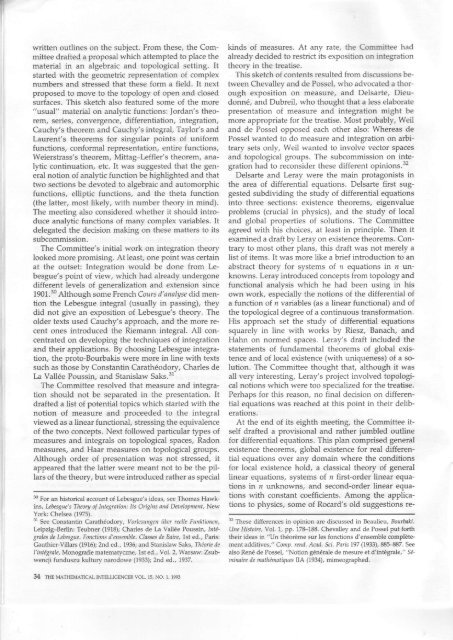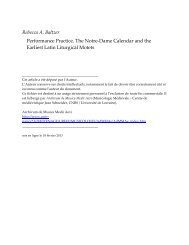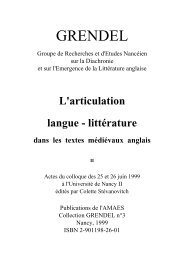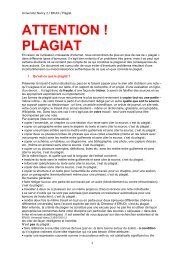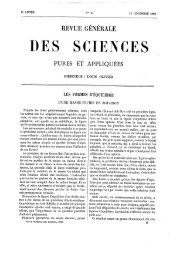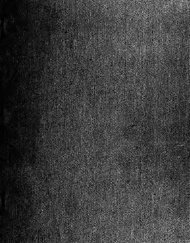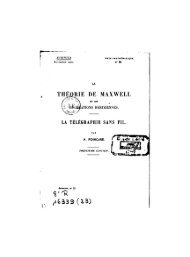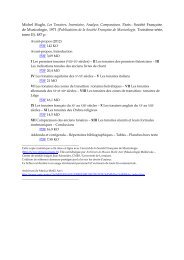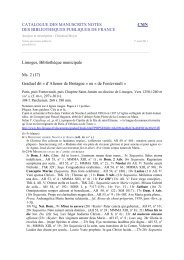Karen V. H. Parshall" A Parisian Café and Ten Proto-Bourbaki ...
Karen V. H. Parshall" A Parisian Café and Ten Proto-Bourbaki ...
Karen V. H. Parshall" A Parisian Café and Ten Proto-Bourbaki ...
You also want an ePaper? Increase the reach of your titles
YUMPU automatically turns print PDFs into web optimized ePapers that Google loves.
î'<br />
written outlines on the subiect. From these, the Committee<br />
drafted a proposal which attempted to place the<br />
material in an algebraic <strong>and</strong> topological setting. It<br />
started with the geometdc representation of cornplex<br />
numbers <strong>and</strong> stressed that these form a field. It next<br />
proposed to move to the topology of open <strong>and</strong> dosed<br />
surfaces. This sketch also featured some of the more<br />
"usual" material on analytic functions: Jordan's theorem,<br />
series, convergence, differentiation, integration,<br />
Cauchy's theorem <strong>and</strong> Cauchy's integral, Taylor's <strong>and</strong><br />
Laurent's theorems for singular points of uniform<br />
functions, conformal representation, entire functions,<br />
Weierstrass's theorem, Mittag-Leffler's theorem, analytic<br />
continuation, etc. It was suggested that the general<br />
notion of analytic function be highlighted <strong>and</strong> that<br />
two sections be devoted to algebraic <strong>and</strong> automorphic<br />
functions, elliptic functions, <strong>and</strong> the theta function<br />
(the latter, most likely, with number theory in mind).<br />
The meeting also considered whether it should introduce<br />
analytic functions of many complex variables. It<br />
delegated the decision making on these matters to its<br />
subcommission.<br />
The Committee's initial work on integration theory<br />
looked more promising. At least, one point was certain<br />
at the out6et: Integration would be done from Lebesgue's<br />
point of view, which had already undergone<br />
different levels of qeneralization <strong>and</strong> extension since<br />
1901 . 30 kinds of measures. At any rate, the Comrnittee had<br />
already decided to restrict its exposition on integration<br />
theory in the treatise.<br />
This sketch of contents resulted from discussions between<br />
Chevalley <strong>and</strong> de Possel, who advocated a thorough<br />
exposition on measure, <strong>and</strong> Delsarte, Dieudonné,<br />
<strong>and</strong> Dubreil, who thought that a less elaborate<br />
presentation of measure <strong>and</strong> integration might be<br />
more appropriate for the treatise. Most probably, WeiI<br />
<strong>and</strong> de Possel opposed each other also: Whereas de<br />
Possel wanted to do measure <strong>and</strong> integration on arbitrâry<br />
sets orùy, Weil wanted to involve vector spaces<br />
<strong>and</strong> topological groups. The subcommission on integration<br />
had to r.eionsid"t these different opinions.32<br />
Delsarte <strong>and</strong> Leray were the main protagonists in<br />
the area of differential equations. Delsarte first suggested<br />
subdividing the study of differential equations<br />
into three sections: existence theorems, eigenvalue<br />
problems (crucial in physics), <strong>and</strong> the study of local<br />
<strong>and</strong> global properties of solutions. The Committee<br />
agreed with his choices, at least in principle. Then it<br />
examined a draft by Leray on existence theorems. Contrary<br />
to most other plans, this draft was not merely a<br />
Iist of items. It was more like a brief introduction to ar<br />
abstract theory for systems of n equations in n unknowns.<br />
Leray introduced concepts from topology <strong>and</strong><br />
Although some French Cozrs d'analyse did nen-<br />
functional analysis which he had been using in his<br />
own work, especially the notions of the differential of<br />
tion the Lebesgue integral (usually in passing), they a function of n variables (as a linear functional) <strong>and</strong> of<br />
did not give an exposition of Lebesgue's theory. The the topological degree of a continuous transformation.<br />
older texts used Cauchy's approach, <strong>and</strong> the more re- His approach set the study of differential equations<br />
cent ones inhoduced the Riemann integral. All con- squarely in line with works by Riesz, Banach, <strong>and</strong><br />
centrated on developing the techniques of integrâtion Hahn on normed spaces. Leray's draft included the<br />
<strong>and</strong> their applications. By choosing Lebesgue integra- statements of fundamental theorems of global existion,<br />
the proto-<strong>Bourbaki</strong>s were more in line with texts tence <strong>and</strong> of local existence (with uniqueness) of a so-<br />
such as those by Constantin Carathéodory, Charles de lution. The Committee thought that, although it was<br />
La Vallée Poussin, <strong>and</strong> Stanislaw Saks."<br />
all very interestinç, Leny's project involved topologi-<br />
The Committee resolved that rneasure <strong>and</strong> integracal notions which were too specialized for the treatise.<br />
tion should not be seDarated in the presentation. It Perhaps for this reason, no final decision on differen-<br />
drafted a list of potentiàl topics which itarted with the tial equations was reached at this point in their delib-<br />
notion of measure <strong>and</strong> proceeded to the integral eranons.<br />
viewed as a linear functional, stressing the equivalence At the end of its eighth meeting, the Committee it-<br />
of the two concepts. Next followed particular types of self drafted a provisional <strong>and</strong> rather jumbled outline<br />
measures <strong>and</strong> integrals on topological spaces, Radon for differential equations. This plan comprised general<br />
measures, <strong>and</strong> Haar measures on topological groups. efstence theorems, global existence for reai differen-<br />
Although order of presentation was not stressed, it tial equations over any domain where the conditions<br />
appeared that the latter were meant not to be the pil- for local existence hold, a classical theory of general<br />
lars of the theorv, but were introduced rather as special linear equations, systems of z first-order linear equations<br />
in z unknowns, <strong>and</strong> second-order linear equations<br />
with constant coefficients. Among the applications<br />
to physics, some of Rocard's old suggestions re-<br />
s<br />
For an historical account oI Lebesgue's ideâs, see Thomas Hawki^s,<br />
Izbesgue's Theory of lftte9ratiofl: lts Oigi\s afld Danloryent, Nevr<br />
Yorkr Chelsea (1975).<br />
31<br />
See Constantin Carathéodory, Vorlesungen iiber reelle Funktiotutt,<br />
Leipzig-Berlin: Teubner (1918); Charles de La Vallée Poussin, lnfégrûles<br />
de Lebesgue. Fonctiont il'ensemble. Classes de Baire,lsl ed., Paris:<br />
Gauthier-Villa$ (1916); 2nd ed., 1936; <strong>and</strong> Stard'slaw Saks, Théorie de<br />
I'intéyale, Mo ogmlie matematyczne, 1st ed., Vol. 2, warsaw: Zsubwencji<br />
funduezu kultury narodowe (1933); 2nd ed., 1937.<br />
34 rm uerr+uercel rNrELucENcER vot-. 15, No. 1,1s93<br />
32<br />
These differences in opinion are discussed in Beâulieu, Bo!rù!,ti.<br />
Une Histoîe, !ol. 1, pp. 178-188. Chevalley <strong>and</strong> de Possel put forth<br />
their ideas in "Un théorème sur les fonctions d'ensemble complète.<br />
ment additives," Cot?rp. tutd. Acad. Sci. Palis 197 (1933), 88H87. See<br />
also René de Possel, "Notion générale de mesure et d'intégrale," 5émiwie<br />
de msthénaliques llA (1934), mimeographed.


